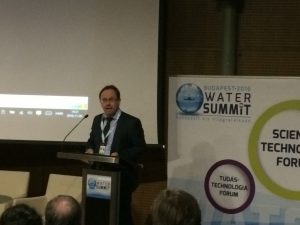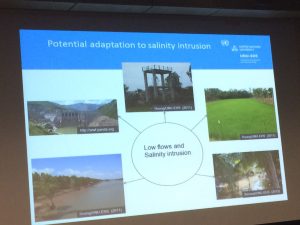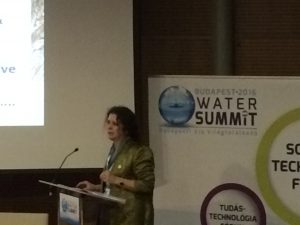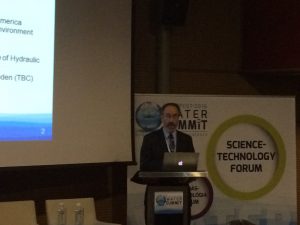Report on the Science and Technology Forum: Budapest Water Summit 2016
The following is the report of the Science-Technology Forum sessions that took place during the Budapest Water Summit 2016, and was convened by the Sustainable Water Future Programme, the International Institute for Applied Systems Analysis, the Institute of Advanced Studies Kőszeg and the Budapest University of Technology and Economics.
—
 “To live like a fish in the water” might no longer the expression of a good life. There are few places in the world today where a high degree of water security and safety for humans has been achieved without threatening our environment and ecosystem.
“To live like a fish in the water” might no longer the expression of a good life. There are few places in the world today where a high degree of water security and safety for humans has been achieved without threatening our environment and ecosystem.
As competition for water between societal needs and ecosystem demand will intensify in the future, securing water for human needs as well as safeguarding the quality and quantity of water for ecosystems is challenging in meeting water supply and sanitation goals. The question is how we balance the water needs of human and nature. Rivers basins, for example, are complex socio-ecological systems connected to the well being of millions of people, culture, and repositories of precious aquatic species and biodiversity. An environmental flow is a well-accepted concept to protect the quantity, timing, and quality of water flows required to sustain freshwater and estuarine ecosystems and the human livelihoods and well-being that depend on these ecosystems. There has been good progress in recognising the importance and implementing environmental flows.
However, there is a need to integrate scientific knowledge into environmental flow determination and implementation more effectively and to establish common approaches for understanding the inter-dependencies of rivers and human communities. For instance, there are challenges in modelling environmental flow during low flow regime even there is a strong recognition that several species are sensitive to the extraction of water during low flow.
 Salinity intrusion in the coastal areas is another complex socio-ecological challenge that requires complex solutions on different spatial and temporal scales. These may involve changes in upstream water and sediment management, changes in water use in agriculture and aquaculture in the deltas, as well as in policies and regulations. Infrastructure development as it is done for decades has to be revisited. Locally appropriate, adaptive and equity-oriented solutions may involve grey, green or hybrid measures as protection from or adaptation to salinity intrusion and need to tackle the root causes of the problem as opposed to providing a fast fix. There will be trade-offs, and each delta needs to negotiate its unique fit-for-purpose solution locally.
Salinity intrusion in the coastal areas is another complex socio-ecological challenge that requires complex solutions on different spatial and temporal scales. These may involve changes in upstream water and sediment management, changes in water use in agriculture and aquaculture in the deltas, as well as in policies and regulations. Infrastructure development as it is done for decades has to be revisited. Locally appropriate, adaptive and equity-oriented solutions may involve grey, green or hybrid measures as protection from or adaptation to salinity intrusion and need to tackle the root causes of the problem as opposed to providing a fast fix. There will be trade-offs, and each delta needs to negotiate its unique fit-for-purpose solution locally.
More than a half a billion people worldwide live on deltas, and many in mega-cities such as Shanghai, Dhaka and Bangkok. There is a need to balance the use of water from both surface and groundwater sources and to acknowledge the fact that urban planning that attempts to modify natural systems have a higher risk of failure during extreme climate events. Historical knowledge of interventions was often more sensitive to environmental systems.
Planning urban settlements of the future must give due consideration to efficient urban design. Compact designs will have a reduced impact on surrounding ecosystems and resources. Smaller urban centres will be particularly vulnerable to extreme climate events, and they are the urban areas with the least capacity. Regarding implementation, resilience schemes go way beyond protecting from extreme climate events and impact on livelihoods and job opportunities.
Socio-economic and environmental considerations may guide new approaches to the much-needed redesign of urban areas and living space. Inter-disciplinary approaches are currently lacking in the design of resilient processes.
 Withdrawals from aquifers (“the Commons”) have increased 300% since the 1950’s bringing huge socio-economic benefits. However, aquifer resources remain quite widely misunderstood, seriously undervalued, poorly managed and inadequately protected. It is noted that sustainable groundwater is a universal prerequisite for achieving the UN-2030 SDGs, and also for avoiding social conflict and reducing forced migration at a variety of scales. Ground water is often neglected in urban resilience planning as information on quantity and resource capacity is poor.
Withdrawals from aquifers (“the Commons”) have increased 300% since the 1950’s bringing huge socio-economic benefits. However, aquifer resources remain quite widely misunderstood, seriously undervalued, poorly managed and inadequately protected. It is noted that sustainable groundwater is a universal prerequisite for achieving the UN-2030 SDGs, and also for avoiding social conflict and reducing forced migration at a variety of scales. Ground water is often neglected in urban resilience planning as information on quantity and resource capacity is poor.
To make “invisible” groundwater visible, it should be quantified and measured using science-based hydrogeological methods. While structured institutional and regulatory solutions exist, they need to be supplemented by incentives that change former behaviour and encourage more efficient and productive use. There are no silver bullets, and especially in groundwater management, one size will not fit all hydrogeological and socioeconomic topologies. Policies and institutional structures can be developed that are locally applicable and likely to give useful quantity and quality outcomes. Closely linked to this is the access to investment finance, though there are critical pitfalls that have to be addressed.
Governance frameworks vary within and across countries. The ability of sound science, including that developed collaboratively in a transboundary context, to influence groundwater policy and management will be enhanced by carefully developed engagement/communication efforts. It is critical to replenish depleted aquifers by infrastructure investment in managed aquifer recharge.
Scientific research can play a strong role in facilitating the implementation of SDGs through assessments and policy engagement from global to local scales.
 Development of scientifically sound assessment and regulatory guidelines that can help to address the gaps in process understanding focusing on the interaction between stressors and their impacts on the human water security and ecosystem health of freshwater bodies. It is key is to understand the linkages, the direction of the linkages (positive or negative) and the strength of the linkages between the various SDG goals and targets. This could be one of the important ways to understand and assess risk in SDG implementation.
Development of scientifically sound assessment and regulatory guidelines that can help to address the gaps in process understanding focusing on the interaction between stressors and their impacts on the human water security and ecosystem health of freshwater bodies. It is key is to understand the linkages, the direction of the linkages (positive or negative) and the strength of the linkages between the various SDG goals and targets. This could be one of the important ways to understand and assess risk in SDG implementation.
Science, for instance, can play a role in providing an in-depth understanding of the links between water, phosphorus, nitrogen and carbon cycles and other pollutants, assessing the magnitude and the impact of these pollutants on water quality and in determining how these impacts could be reduced and controlled. Such assessment capability should be developed that will focus on specific problems including the inter-linkages among the SDGs.
Transparent, open data and user-friendly models along with a philosophy of adaptation are needed in addressing the trade-offs between the various options. Local authorities also need such data for making effective decisions.
There are opportunities for co-design of solutions by collaborative scientific, sponsor and stakeholder groups. Stakeholder engagement can help reduce the uncertainties in planning scenarios. Partnerships with water operators, for instance, can be a useful tool to promote resilience of urban systems with a focus on urban regulation, zoning and creating economic incentives. Urban utilities have a key role to play in leading urban resilience initiatives and are frequently the key local organisations with the knowledge and information required.
The implementation of solutions in implementing SDG6 targets may rely on the effective development of science-based knowledge solutions co-designed with different stakeholder groups and investment of appropriate infrastructure.
 Acknowledgement and Thanks
Acknowledgement and Thanks
To enable the preparation of this report, we would like to thank the following session rapporteurs for their vital contributions:
- Mr Jan Leentvaar, United Nations Educational, Scientific and Cultural Organisation – International Institute for Hydraulic and Environmental Engineering, Institute for Water Education, The Netherlands
- Ms Zita Sebesvári, United Nations University, Institute for Environment and Human Security, Germany
- Ms Teodóra Szőcs, Geological and Geophysical Institute, Hungary
- Mr Graham Alabaster, United Nations Human Settlements Programme
- Mr Richard Lawford, Morgan University, United States of America
Further Information:
News Item Courtesy Of:
Anik Bhaduri
Executive Director
Water Future
19 December 2016